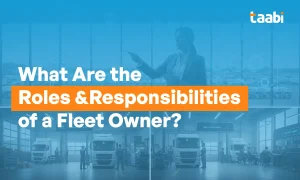Today’s fleet managers navigate a labyrinth of challenges, from skyrocketing operational costs to stringent environmental regulations. They grapple with the optimization of vehicle maintenance, fuel consumption, and driver performance, all while ensuring compliance with an ever-expanding web of legal requirements. The complexity of these tasks is compounded by the pressure to deliver goods faster and more reliably in an increasingly competitive market.
Fortunately, AI can equip fleet managers with cutting-edge fleet management software to tackle the above-mentioned complexities. AI promises not just to streamline operations but to revolutionize them. As we look to the horizon of 2023, ten groundbreaking innovations stand out, poised to redefine the benchmarks of fleet management. From advanced predictive analytics that forecast vehicle maintenance needs to AI-driven route optimization algorithms that promise unparalleled efficiency, these developments are set to unlock new potentials.
We will discuss real-time tracking systems that provide granular visibility into fleet operations, eco-friendly initiatives that align with green mandates, and intelligent automation that elevates the productivity of every fleet manager. Each innovation represents a gear in the well-oiled machine of modern fleet management software, working in concert to drive the industry forward into a new era of digital sophistication.
Innovation 1: Autonomous Vehicle Technology
- Sensors and Cameras: These act as the eyes of the vehicle, providing a 360-degree view and capturing real-time data about the vehicle's surroundings.
- LIDAR and RADAR: These systems measure distances and detect objects around the vehicle, contributing to a detailed understanding of the environment.
- Machine Learning Algorithms: They process the data collected to make instantaneous navigation decisions, learn from patterns, and improve over time.
- GPS and Mapping Software: These provide precise location tracking and route planning capabilities.
- Vehicle-to-Everything (V2X) Communication: This allows the vehicle to communicate with other vehicles, infrastructure, and networks to improve safety and traffic flow.
Innovation 2: Electric Fleet Adoption
- Electric Vehicles (EVs): These are vehicles powered by electric motors, which draw energy from rechargeable battery packs.
- Charging Infrastructure: A network of charging stations is required to power EVs. This includes the installation of various types of chargers, such as Level 1, Level 2, and DC Fast Chargers, depending on the required speed of charging and vehicle types.
- Battery Technology: Advances in battery technology are crucial for increasing the range and reducing the weight and cost of EVs.
- Energy Management Systems: These systems help in monitoring and managing the energy use of each vehicle, optimizing charging times, and reducing electricity costs.
- Regenerative Braking: A technology that recovers energy typically lost during braking, converting it into electricity to recharge the battery.
The adoption of electric fleets fundamentally alters several aspects of fleet management:
- Operational Costs: EVs can significantly reduce fuel costs and have fewer moving parts, leading to lower maintenance expenses.
- Environmental Impact: Electric fleets contribute to a reduction in greenhouse gas emissions, helping companies meet sustainability goals.
- Fleet Operations: The management of charging schedules and the tracking of energy consumption become new focal points.
Innovation 3: Predictive Analytics
- Data Collection: Vehicles equipped with sensors and telematics devices collect and transmit a vast array of data in real-time, including engine performance, driving patterns, and vehicle diagnostics.
- Data Processing: This raw data is then processed and analyzed using advanced algorithms that can detect patterns and anomalies.
- Machine Learning: Over time, machine learning models adapt to the data, becoming more accurate in predicting potential issues and maintenance needs.
- Actionable Insights: The system translates these predictions into actionable insights, providing fleet managers with recommendations for preventive maintenance or route adjustments.
Innovation 4: IoT and Telematics
- Sensors: Vehicles are equipped with various sensors that monitor everything from fuel consumption to tire pressure.
- Connectivity:These sensors are connected to the internet, allowing them to send data to a central system. This connectivity can be achieved through various means, including cellular networks, Wi-Fi, and satellite communications.
- Data Analytics: The data collected is analyzed to provide insights into vehicle performance and operational efficiency.
- Telematics Devices: These are the hardware components installed in vehicles that capture and transmit data. They often include GPS tracking capabilities and interfaces for driver communication.
Innovation 5: AI-Driven Route Optimization
- Machine Learning Models: These are trained on historical data to understand traffic trends and predict future conditions.
- Dynamic Routing Algorithms: They adjust routes in real-time, responding to unexpected events like traffic jams or road closures.
- Geospatial Data Analysis: This involves analyzing geographic information to understand the terrain, which can affect vehicle performance and route selection.
- Integration with Telematics: AI uses data from vehicle telematics to tailor routes that align with vehicle capabilities and driver hours of service.
Innovation 6: Blockchain for Fleet Management
- Decentralization: Information is distributed across a network of computers, not stored in a single location, which enhances security and resilience.
- Immutable Records: Once data is entered into the blockchain, it cannot be altered, creating an accurate and permanent record of every transaction.
- Smart Contracts: These are self-executing contracts with the terms directly written into code, which can automate processes like payments and confirmations when predefined conditions are met.
- Transparency: All parties with permission can view the transaction history, ensuring a high level of transparency in operations.
Innovation 7: Advanced Driver-Assistance Systems (ADAS)
- Sensors and Cameras: These are the 'eyes' of the system, providing real-time data on the vehicle's surroundings.
- Software Algorithms: They interpret sensor data to identify objects, lane boundaries, and read traffic signs.
- Actuators: In critical situations, these can take control of the vehicle to apply brakes or adjust steering.
- User Interface: Feedback to the driver is often provided through visual, auditory, or haptic signals.
Innovation 8: Fleet Electrification Management Tools
- Charging Infrastructure Management: Software to manage the availability and utilization of charging stations.
- Battery Performance Analytics: Algorithms that monitor battery health and predict longevity, optimizing charging cycles and vehicle usage.
- Energy Consumption Optimization: Tools that analyze and adjust energy usage patterns to reduce costs and improve efficiency.
- Grid Integration: Systems that communicate with the electrical grid to take advantage of lower rates and renewable energy availability.
Innovation 9: Integrated Mobility Solutions
- Multi-Modal Transportation Management: Software that can handle scheduling, booking, and routing across different transportation modes.
- Unified Communication Systems: Platforms that allow for real-time updates and information sharing between drivers, fleet managers, and passengers.
- Data Aggregation and Analytics: Tools that collect and analyze data from all transportation modes to optimize usage and reduce costs.
- User-Centric Interfaces: Applications that provide end-users with intuitive access to mobility options, booking, and payment systems.
Innovation 10: Enhanced Cybersecurity Measures
- Encryption: Strong encryption protocols for data at rest and in transit, ensuring that sensitive information is unreadable to unauthorized parties.
- Intrusion Detection Systems (IDS): Software tools that monitor network traffic for suspicious activities and potential threats.
- Regular Software Updates and Patch Management: Keeping fleet management software and its components up to date with the latest security patches.
- Access Control: Robust authentication and authorization processes to control who can access the fleet management system and what they can do within it.
The Role of Taabi in Providing Cutting-edge and Advanced Fleet Management Solutions
- Fleet Fuel Monitoring: Taabi's system meticulously tracks fuel usage, identifies patterns, and suggests optimizations to cut costs and improve efficiency.
- Fleet Health Management: Proactive maintenance is made possible with Taabi's predictive analytics, which monitors vehicle health and alert managers to potential issues before they escalate.
- Digital Locking Systems: Enhance the security of your assets with Taabi's digital locking systems, which provide tamper alerts and access control.
- Advanced Routing Optimization: Taabi's software processes countless data points to determine the most efficient routes, saving time and reducing wear on vehicles.
- Fleet Load Capacity Optimization: Maximize your fleet's potential with algorithms that ensure each vehicle is utilized effectively, balancing load distribution for optimal performance.
- Fleet Driver Behavior Management: Monitor and manage driver performance to ensure compliance with safety standards and efficiency practices.
- Advanced Live Driver Guidance System: Support your drivers with real-time guidance, helping them navigate routes safely and efficiently.
- Real-time Fleet Operations Data Analysis: Gain insights into your operations with live data analysis, enabling swift decision-making and strategic planning.
- Real-time Fleet Tracking: Keep a vigilant eye on your fleet with real-time tracking that ensures you know where your vehicles are at all times.








